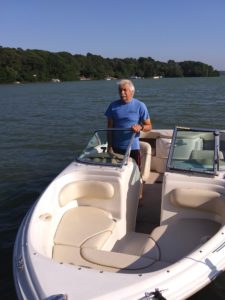President’s Letter Fall 2022
 There is still plenty of nice weather left to enjoy our cyanobacteria-free watershed. Aside from swimming, fishing and boating, have you tried a mushrooming hike on the Commassakumkanut Preserve on Roxy Cahoon Road or a search for cranberries in the old bog near the Alpert Nature Preserve off Little Herring Pond Road? Better still, have you taken a kayak up the Carters River between Great Herring Pond and Little Herring Pond? Not a sign of civilization for about a mile.
There is still plenty of nice weather left to enjoy our cyanobacteria-free watershed. Aside from swimming, fishing and boating, have you tried a mushrooming hike on the Commassakumkanut Preserve on Roxy Cahoon Road or a search for cranberries in the old bog near the Alpert Nature Preserve off Little Herring Pond Road? Better still, have you taken a kayak up the Carters River between Great Herring Pond and Little Herring Pond? Not a sign of civilization for about a mile.
Did you go on one of Brian Harrington’s and Martha Sheldon’s spring bird walks? Have you seen a great blue heron spear a fish? Have you counted the herring swarming up the Herring River to spawn? Did you catch the GHP Fourth of July fireworks display? Did the toads drown them out this year? Have you witnessed an osprey catching a fish claws-down?
We have a lot to be thankful for. But we also have a lot we need to take care of. At long last, we have received our first draft of the Water Quality Plan. Too much phosphorus is the problem. According to the draft, most of it comes from resident septic systems. There are other sources, and our Herring Ponds Watershed Association review committee, Plymouth and Consultant partners will help us find ways to reduce as much of the phosphorus pollution as we can.
This seems a good time to look toward the future a bit. All of us should pay more attention to our septic systems since they are a major source of pollution and algae and cyanobacteria blooms. It is important that all our watershed residents know that septic tanks should be checked and pumped every three to five years. More houses will make more pollution so it seems logical that we should continue to help Plymouth preserve land in our watershed recharge area. Phosphorus is found in fertilizers so we should tell our landscapers to use phosphorus-free fertilizer. Pet waste contains large amounts of phosphorus and should be removed from a yard quickly. We all would love a million-dollar view of our pond, but the long-range cost of the resultant phosphorus runoff from removing vegetation could well exceed a million dollars.
I have faith in our watershed constituency. We could work together to plant rain gardens where sanitary sewers empty into our ponds. We could help each other replant bushes, trees and shrubs that would hold the soil in place. Would we help educate each other to improve watershed quality of life? Could we raise money to match grants?
Support our efforts with your dues.
We have only to ask ourselves what will be left of the watershed if we do nothing.
Don Williams
President, HPWA

I know that the report is a long document (close to 150 pages if I recall correctly).
I am aware that the board wants to read it first and perhaps ask the consultants for some clarifications before making it available to the community at large.
In the mean time and short of reading it all, can the members of the HPWA be able to read the Executive Summary which I hope was provided with the report.
Thanks,
Nicole
That question has a long and complicated answer. They considered runoff (because they did the study half a decade ago) but because the largest contributor sites of phosphorus (according to their study) had been remediated, they did not think that runoff was a major contributor. Even though the largest single contributor of GHP’s phosphorus is LHP (47%), there was no consideration of LHP runoff (LHP runoff was not considered in the earlier study either), even though LHP has, like GHP considerable slopes.
The review committee has not given up on runoff and will talk with Plymouth about the possibility of doing another runoff study. We cannot sewer our watershed in a reasonable amount of time and it would be very expensive for our residents to do so. Accordingly, we have the time and the motivation to dig deeper into possible phosphorus sources. We have done that and, so far, at least in my opinion, runoff is a good place to start. Others are being investigated.
Our next step is to talk with our Plymouth partners (Kim Tower and David Gould) and get their opinions and their ideas about our opinions.
Thanks for your continuing interest.
Don